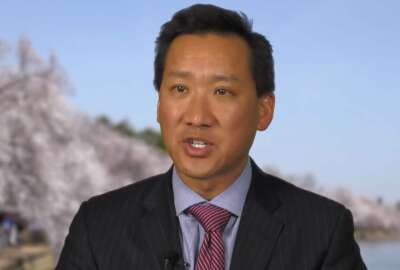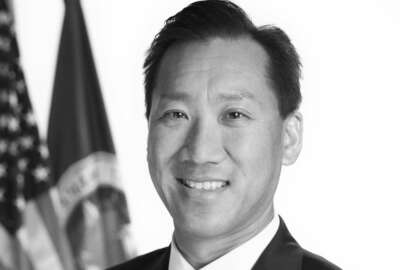
OPM’s Pon pushing for major civil service changes, from retirement to veterans preference
New Office of Personnel Management Director Jeff Pon detailed his vision for OPM and its role in modernizing 40-year-old statutes that govern how agencies recruit,...
Best listening experience is on Chrome, Firefox or Safari. Subscribe to Federal Drive’s daily audio interviews on Apple Podcasts or PodcastOne.
Is 2018 the year that government will finally tackle the seemingly ambiguous and daunting task of civil service “reform?”
For new Office of Personnel Management Director Jeff Pon, it is.
In a wide-ranging conversation with reporters Monday morning, Pon outlined his vision for OPM and its role in modernizing 40-year-old statutes that govern how agencies recruit, retain, compensate and manage federal employees.
“We’ve been nibbling around the edges of civil service reform in the [19]90s and also in the 2000s,” Pon said. “We’ve looked at pay systems, but I’m really looking at wholesale change. We’re looking to make sure that the fabric of the civil service is ready for the next 40 years.”
OPM can push change with four main mechanisms: legislation, executive order, agency-specific authority and OPM authorities.
“I’m going to be pushing on all four,” Pon said. “We are going to ask our legislators on ambitious things. We are going to ask for greater authorities for the OPM director to make sure that this position can manage agency-wide HR policies.”
The OPM director actually has a lot of administrative authority that the agency hasn’t used in years, Pon said.
Moving forward, that will change. OPM will be busy in the next six-to-seven-months pushing new legislative ideas out the door, Pon said.
“Do I anticipate everything to work and go through? No. I’ve already from my colleagues saying, maybe Pon is biting off too much. I actually look at it a different way,” he said. “I’m going to ask. The worst that they can say is no. But we will ask. And we will lead. And we will be brave about our leadership here at OPM.”
Civil service reform
New civil service ideas will touch on nearly every aspect of the federal workforce, from hiring and pay and benefits, to the Senior Executive Service.
In his first month or so on the job, Pon has been speaking with agencies about their own specific wish-lists and what barriers they have to hire top talent.
As Pon described in his first “welcome video” to federal workforce, OPM is helping agencies develop new personnel systems to help organizations better recruit, retain and manage employees with mission-critical skills.
“We’returning a new leaf here and we’re making sure that agencies have more flexibilities, not just at the agency level, but if I can’t do it at the agency level, then I’ll do it at the occupation level,” Pon said. “That’s within the authorities of the director. It doesn’t need legislation.”
Specifically, agencies may soon see new flexibilities around veterans preference.
“We are going to be updating organizations on how to hire veterans as well,” Pon said. “Although we have veterans preference that is implemented and is clunky, I would like to encourage agencies to actually have a talk with veterans groups and work with them on the occupations and jobs that veterans actually want. OPM is going to be urging them to hire a certain number of veterans into those jobs.”
And perhaps, unsurprisingly, federal employees’ retirement plans may get a second look from OPM and the Trump administration.
“We might take a look at defined contribution and defined benefits plans too,” Pon said. “We want to make sure that new employees, not just new entries like college-grads but mid-level and late career people, can join the federal government and actually take their benefits with them, like a 401(k).
Federal unions will be a part of the debate, Pon said. But he wants to make sure everyone involved in these discussions are using the same data set from multiple sources to review all federal occupations and their compensation. Traditionally, OPM relies on the Congressional Budget Office and the Bureau of Labor Statistics to compare federal and private sector compensation data, but those sources
“I want to make sure that the unions, the legislators, the White House, ourselves [and] everybody has [a] similar type of data so we know potentially how to evaluate are we underpaying or are we overpaying and targeting those different types of jobs that are strategic?” he said.
In the future, OPM will review the occupations that need more attention, such as science, technology, engineering and math (STEM) positions, as well as defense and intelligence areas. Different occupations may require different approaches to pay, benefits and other types of compensation, Pon said.
Pon is also reviewing the original mission and objectives behind the Senior Executive Service. He’s discussing options to modernize the SES with the Senior Executives Association.
“We’re in discussions on how it should work, what types of training we need to have, what types of rotations we need to have, what type of credentials SES should have,” Pon said. “It’s not just about a year or two-year probationary period. It’s literally looking at SES … as ‘our executive athletes’ for the government and making sure those 7,000 people can be a resource for the whole of government versus just one agency or a sub-agency for a long, long time.”
Digital HR solutions
The goal, Pon said, is to digitally track an employee’s entire federal career from recruitment and hiring to retirement.
Pon recently visited OPM’s site in Boyers, Pennsylvania, where the agency still processes federal employees’ retirement applications by paper. That experience, and his initial onboarding back into the federal workforce, is inspiring OPM’s work on IT modernization.
“It’s making sure that our federal workers, and our citizens and our job applicants can take this expectation of things working and delivering information at a touch versus calling and getting paper and waiting three days for an ID or a password,” Pon said.
The civil service reform package will be aggressive and ambitious, but Pon said he also wants to make sure OPM plays a role in celebrating the good news stories of federal employees.
The 40th anniversary of the Civil Service Reform Act of 1978 falls on Oct. 13, and OPM will commemorate the day later this year.
Copyright © 2025 Federal News Network. All rights reserved. This website is not intended for users located within the European Economic Area.
Nicole Ogrysko is a reporter for Federal News Network focusing on the federal workforce and federal pay and benefits.
Follow @nogryskoWFED
Related Stories





